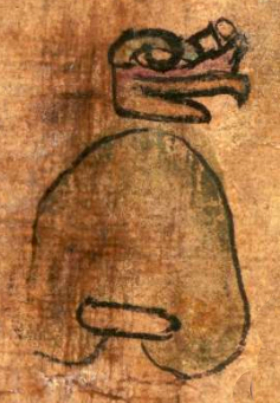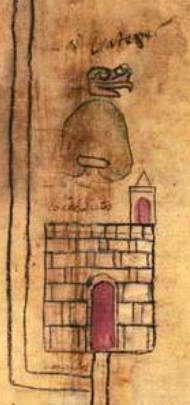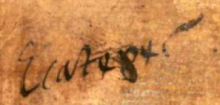Ecatepec (CQ)
This compound glyph for the place name Ecatepec ("On Wind Hill" or "On the Hill of Ehecatl")
has two main features. One is the head of what appears to be a bird, but which represents the wind and the divine or sacred force associated with the wind, Ehecatl. The head is shown in profile, facing to the viewer's right. Its three-part beak has a point on the top level, a long middle section with a downward hook, and a shorter lower section. The head is painted turquoise blue, red, and yellow or gold. On top of the beak are a small white square and a small white circle. The other predominant feature of this compound glyph is a standard, bell-shaped mountain or hill (tepetl), rounded, green and brown in color, and with a white horizontal marking toward the base.
Stephanie Wood
Earlier studies of the manuscript, the Codex Quetzalecatzin, suggest that this town of Ecatepec is the one in the northern end of the Valley of Mexico, but the context image shared here suggests that Ecatepec was the name for Todos Santos. The church of Todos Santos is right next to the glyph for Ecatepec. There is a Todos Santos near both Huitziltepec and Tochtepec, other place names shown on the codex. Today Todos Santos has an appellation of Xochitlan, but the name might have evolved over time. Furthermore, one of the governors mentioned on the manuscript was Xochitzin, which may have figured into local place names in some way. Today, these towns are all between the cities of Puebla and Tehuacan.
Sebastián van Doesburg has confirmed that the context for this manuscript, the Codex Quetzalecatzin, is the valley in which the contemporary pueblos of Xochitlan Todos Santos and Santa Cruz Huitziltepec are located. This small valley is between Tlacotepec de Benito Juárez and Molcaxac in the southern part of the modern state of Puebla. [See our Bibliography for the study published by van Doesburg, and see p. 125.] A place called Ehcateopan (perhaps a forerunner of Ecatepec in this region) was the site of the establishment of a settlement and a tecpancalli (ruling house) by Quetzalecatzin and Chicome Tochtli in the year Eleven Reed. The annals of Tecamachalco recount these events. [See van Doesburg, pp. 130–131].
A great many glyphs in this collection start with Eca- when one might expect Eheca-. We are preserving the proclivity of the gloss for Eca-, while also pointing to the likelihood of an unintentional oral abbreviation of Eheca- to Eca-. The gloss for this place name Ecatepec does not reproduce the reduplication at the start of Ehecatl, but the visual is a reference to this divine force. Ehecatl was an aspect of the creator (with Quetzalcoatl associations and with the night). This representation of Ehecatl was apparently how Nahuas here represented the deity associated with the wind. The second sun on the Aztec sun stone has a much more elaborate representation of the wind; and, this epoch was ruled by Quetzalcoatl. The second sun was destroyed by hurricanes and the people were turned into monkeys. For other images of Ehecatl and more information about his shape and that of Quetzalcoatl, see Mexicolore, https://www.mexicolore.co.uk/aztecs/gods/study-the-wind-god. One of the pre-Columbian statues devoted to the wind gives him a monkey's body but the same buccal mask (large point above the mouth, beak, or duck bill) as we see in this glyph. Gabrielle Vail and Christine Hernández (Re-Creating Primordial Time, 2013, ) describe Ehecatl as the wind aspect of Quetzalcoatl, and they note that Ehecatl "wears a buccal (duck) mask through which to blow wind." That the "beak" may have been perceived as a blowing device is supported by the glyph for Pitztli (below).
Many humans (especially men) had the name Ecatl or Ehecatl, which could sometimes feature this representation of the divinity or deity. Wind was a day sign in the calendar. The locative suffix on this place name (-tepec) means on or at the hill or mountain.
Stephanie Wood
Ecatepec
Ecatepec
Stephanie Wood
covers ruling men and women of Tecamachalco through 1593
Stephanie Wood
wind, air, viento, aire, deities, deidades, divinities, divinidades, fuerzas sagradas, xiuhpohualli, año, turquesa, xihuitl, nombres de lugares

eca(tl), air, breath, https://nahuatl.wired-humanities.org/content/ecatl
eheca(tl), wind, wind deity, https://nahuatl.wired-humanities.org/content/ehecatl
tepe(tl), hill or mountain, https://nahuatl.wired-humanities.org/content/tepetl
-tepec (locative suffix), https://nahuatl.wired-humanities.org/content/tepec
P[ueblo] Ecatepec “On Wind Hill” [depicting the wind god’s bird mask]. Matthew T. McDavitt, “Placenames in the Codex Quetzalecatzin,” unpublished essay shared 2-21-2018.
En el Cerro de Ehecatl, o En el Cerro del Viento
Stephanie Wood
The Codex Quetzalecatzin, aka Mapa de Ecatepec-Huitziltepec, Codex Ehecatepec-Huitziltepec, or Charles Ratton Codex. Library of Congress. https://www.loc.gov/item/2017590521/
The Library of Congress, current custodian of this pictorial Mexican manuscript, hosts a digital version on line. It is not copyright protected.








